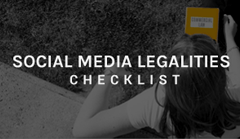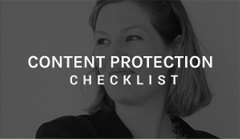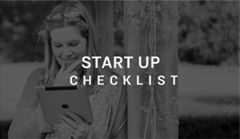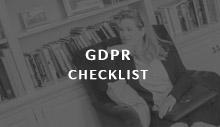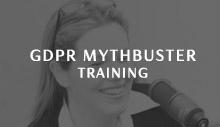Transcript of the Video
Good evening everybody, Suzanne Dibble here, data protection law expert coming to you raw and uncut in a quick video this evening. I wanted to pick up on something that someone had posted in the group about opt-ins, lead magnets and opt-ins. I know this is a big issue for people in the group, mainly.
So I thought it was worth putting on a separate video. I did comment on his post, but I thought it'd be useful for a lot of you in the group.
So, lead magnets. For those of you who don't know what a lead magnet is, it's when you give away a valuable bit of information in exchange for somebody's email address. And the question is, do we have to have a tick box at the point where the person is putting in their email address?
Well, the answer is: not necessarily, because the act of putting in the email address itself is, in my view, an affirmative act which signifies consent. Just for sending the lead magnet. I'm not talking about follow-up marketing, I'm just talking about sending them the lead magnet.
But what the person posted, he said, "Okay, can I do that? Can I get them to pop in their email address and send them the lead magnet, and then, in the email when you send them the lead magnet, can you, at that point, say to them, 'Would you like to receive details of my marketing?'" Obviously, in much better, jazzed-up marketing speak than that.
But you would get your opt-in in the body of the email sending the lead magnet. In my view, that is fine, because you're being upfront, you're getting an affirmative action to get the consent for both things. Both for initially sending the lead magnet, this had been requested by them popping in their email address, and then, for them opting in for further marketing.
Now, remember, it does have to be opt-in, it can't be opt-out. Pre-tick boxes you can't have, but I don't see any reason why you can't separate the process in the way that was suggested in the group.
Now other things to note are that you need to have, you still do need to have a link to your privacy notice, or your privacy policy at the point that they pop in their email address for the lead magnet. So you'd have a little line underneath where they put in their email address that says, "We will collect, use and protect your data in accordance with our privacy policy," link to your privacy policy.
Now, remember, you're not getting people to consent to your privacy policy or notice. I use those words interchangeably. You're only advising people of your privacy notice, but you do need to give it to them at the point of collection of the data.
So you'd have that there, and underneath the lead magnet where people are entering their email address. And then, when you are asking them for the opt-in for further marketing, you would at that point, it's probably worth putting in another link to the privacy notice, even though they've probably had it when they opted in, but put another link to the privacy policy there. And also say that they can opt-out at any time, so that should be there too.
And yes, as I remember, it's opt-in, but not opt-out. But as long as ... Yeah, I don't see why that wouldn't work, because you're getting affirmative, it's an affirmative action, it's clear consent, you're being upfront. I don't see why that can't work.
Now, I don't know whether, statistically, you're more likely to get people to opt-in in the body of an email than on a tick box. On your lead magnet, I don't know. I'm guessing that the person who's asked knows these things and that you are likely to get more people to opt-in once they've actually received the lead magnet.
And I suppose, certainly, if they read the lead magnet and can see that it is of super value and that you're clearly someone that they want to hear from going forwards, then the chance of them ticking that ... even if they don't tick it immediately, they can go back to that email and opt-in. Whereas obviously, if you have a tick box at the point of entering the details, they've not experienced your lead magnet and it's a kind of one-off chance, isn't it?
So I can kind of see the logic there.
So yeah, I think that it's not a bad idea at all. And then do remember, I covered this in my marketing video, marketing training, but do remember the bit about the psychology of people who will ... It's human psychology to put off making decisions if we can. So if you just have an opt-in box or do nothing, then people will err towards doing nothing.
But if you have an opt-in and an opt-out, then it will encourage people to take action. Now obviously if they still don't do anything, even though they're presented with two choices, you would not be able to opt them into your marketing. But psychologically, it encourages people to actually do something, and therefore they're more likely to opt-in.
So yeah, I think that would be an effective way of obtaining consent. It's kind of similar to what I'm doing at the moment with people who are ... Well, it's nearly similar, because we're not, obviously, GDPR isn't in force yet, but I think it's certainly something that I'll be doing going forward with the group, because as people come into the group, we ask them the three questions, one of those is "Would you like to receive our free checklist?" And people put their email address in at that point.
For me, that is affirmative consent: they want to receive that checklist. Then, going forward, when I'm sending them the free checklist, then I will ask them at that point to opt-in to further marketing.
So I hope that's useful for people. Lead magnets and tick boxes, it's a hot topic and rightly so, because a lot of digital marketing businesses rely on that route into people being a customer. If the chances of people not ticking that box to receive further marketing are going to be significantly affected, then we do need to think a little bit outside the box and see what ways we can encourage people to opt-in while still being within the confines of GDPR.
So I hope that's helpful. Thank you to the guy who asked the question, I'll tag you in the comments below. And keep the questions coming. It's always a good exercise of the old gray matter. So whatever you're doing tonight, on a Saturday night, I hope you're enjoying yourselves, I'll see you soon.


